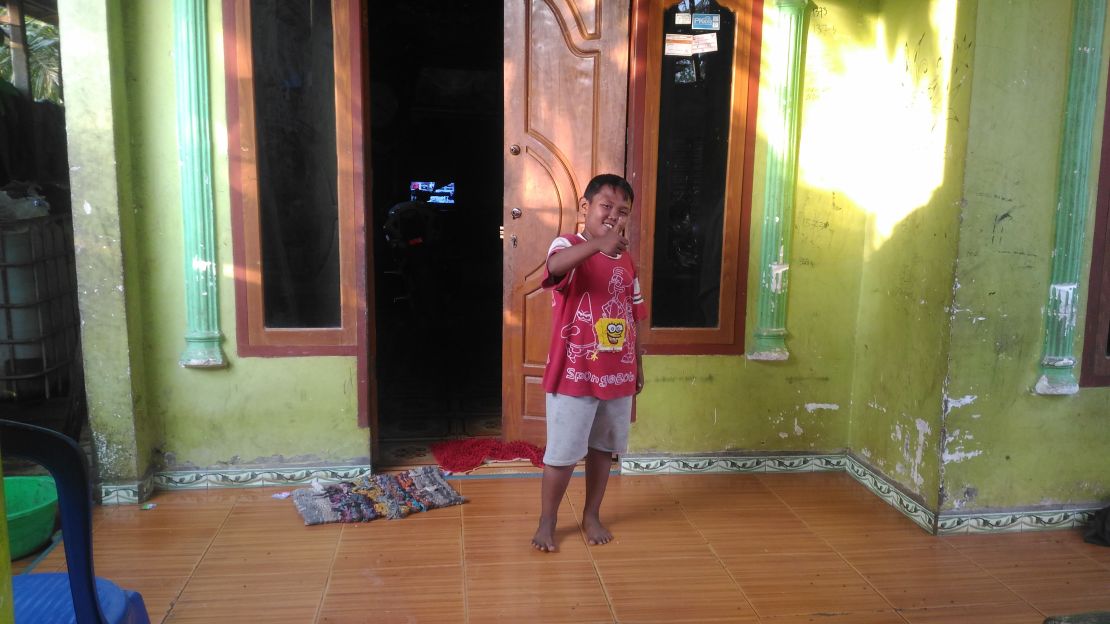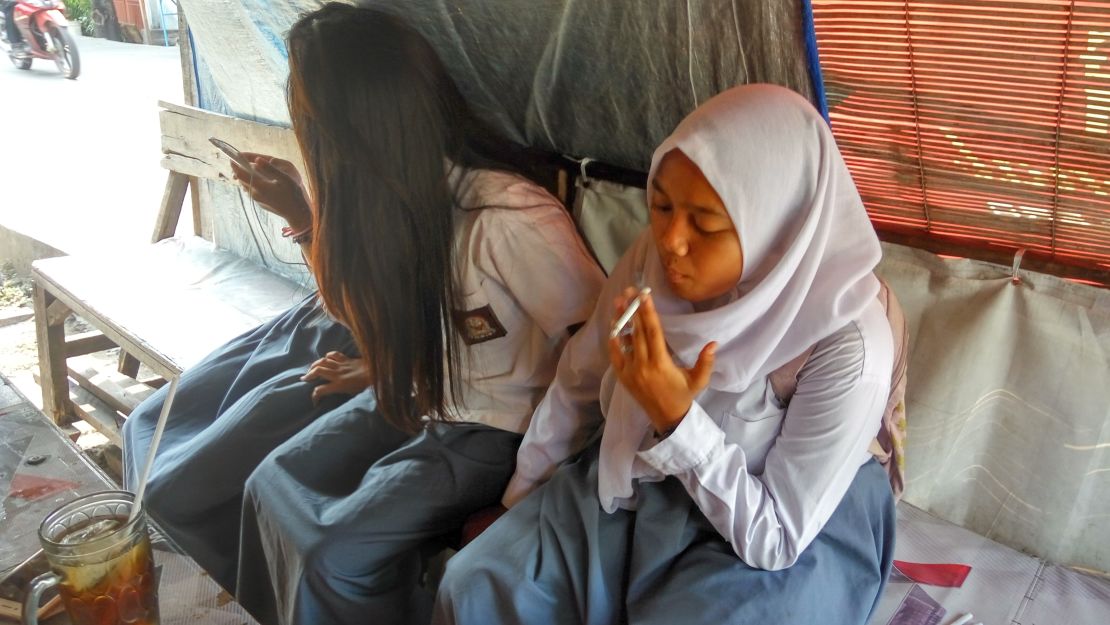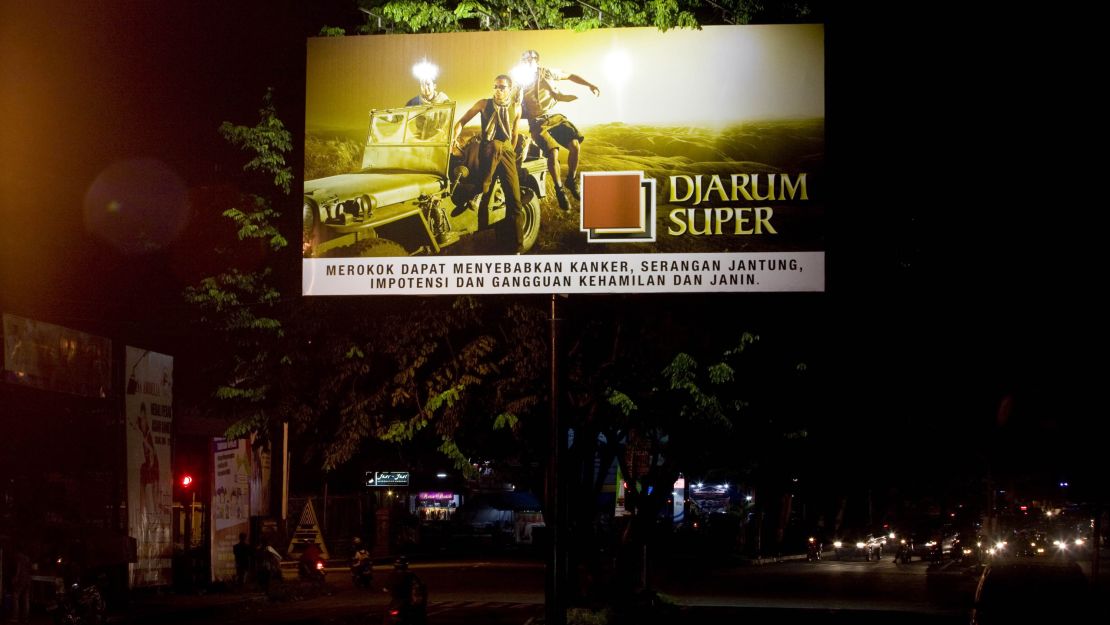Story highlights
Aldi Suganda, now 8, has recovered from a smoking and eating addiction
Millions of Indonesian children ages 10 to 18 continue to smoke, putting their health at risk
Surrounded by farmland and plantations in the small village of Teluk Kemang Sungai Lilin in South Sumatra, a boy, just 8 years old, sits smiling with his mother.
But this boy has a tumultuous past and a reputation that precedes him, having undergone a recovery most children will never face.
Six years ago, Aldi Suganda, also known as Aldi Rizal, was a 2-year-old chain smoker addicted to cigarettes, smoking packs each day. “It was hard for me to stop,” he said. “If I am not smoking, my mouth taste is sour and my head feel dizzy.
“I am happy now. I feel more enthusiastic, and my body is feeling fresh,” he said.
He became a global sensation as the “chain-smoking toddler,” with video clips of him puffing excessively on an endless cigarette supply watched by millions around the world.
His mother, Diana, thinks back to that period and recoils at the memory. Her son would get angry, she remembers, and throw tantrums if she withheld cigarettes from him or failed to give him money to obtain them. “He (would) start to smash his head to the wall. He was crazy, hurting himself if he didn’t get a cigarette,” she said.
People would accuse her of being a bad mother and regularly question her parenting skills, she said. “I am a weak mom. He always threaten me if I didn’t give him money. … I (was) afraid he (was) going to die.”
Aldi is the youngest of three boys born to Diana and her husband, who requested not to be named. But he is far from the only child who picked up the habit across the islands of Indonesia: More than 267,000 children there are estimated to use tobacco products every day.

A childhood habit
Diana believes Aldi’s addiction began with peer pressure and exposure to smokers. He accompanied her each morning to the market where she sells vegetables grown on their land. People there could have taught him to smoke, and he could easily get cigarettes by asking at the market, she said.
In many regions of the world, this might seem unrealistic and like an excuse, but in Indonesia, it’s highly likely. The country has the highest percentage of male smokers globally and among the highest rate of adolescent and child smokers in the world – fueled by lack of control over advertising, relaxed sales and low prices.
Today, Aldi is a healthy young boy who attends school and gets good grades, but to get here, it took years of rehabilitation with the country’s leading child psychologist, Dr. Seto Mulyadi, chairman of the nation’s National Commission for Child Protection. His road also didn’t end with his tobacco cravings. Soon after his recovery, he replaced tobacco with food and began to overeat as a means of compensation, eventually becoming obese.
But a second bout of rehabilitation to tackle this overeating created the healthy, stable young boy sitting beside his mother today.
Mulyadi believes the one benefit of working with children who have an addiction is their mental agility. In Aldi’s case, his age and intelligence meant he responded quickly to his treatment, in which Mulyadi distracted the 8-year-old with running, climbing and playing while slowly reducing the number of cigarettes he smoked each day. But treatment was intense and required Aldi to go to Jakarta for a few months to be with Mulyadi every day.

“He was just 3 years old, and he smoked four packs a day,” Mulyadi said. “(But) I was confident because he is still very young. Psychologically, as a child, he is very flexible and easier to be cured.”
And cured he is – at least for now.
“I don’t want to smoke anymore. I don’t want to get sick,” said Aldi, who now wants to help prevent other children going through a similar ordeal. “Please don’t smoke. Don’t even try it. It’s hard to quit.”
In 2013, more than 57% of men were reported to be smokers in Indonesia and more than 42% of teens ages 13 to 15, according to the Tobacco Atlas, compared with 17% and 8.2%, respectively, in the United States. It’s estimated that more than 217,000 people die from diseases linked to tobacco use each year in Indonesia, including heart disease and respiratory conditions such as emphysema and lung cancer.
With smoking so commonplace and numbers remaining steady or even rising among some groups in recent years, Aldi’s message could go unheard, believes Dr. Lily Sulistyowati, director of prevention and control of noncommunicable diseases at Indonesia’s Ministry of Health.
“I’m very worried about smoking in Indonesia,” she said, especially among teens ages 15 to 19.
No sign of decline
While rates in most countries fell between 2013 and 2016, the rate of smokers under 18 in Indonesia rose from 7.2% to 8.8%. In a population of more than 261 million, that means millions of youth continue to smoke today.
But more worryingly, among 10- to 14-year-olds, more than 3% were smokers in both 2013 and 2016 – the majority of them boys – and more than 18% of boys and more than 9% of girls 10 to 14 had tried a cigarette, according to Indonesia Basic Health Researchdata reported in 2013.
The research also found that 1.5% of boys and 1.4% of girls 5 to 9 years old had tried a cigarette.
Sulistyowati believes the problem is worse in rural areas and among poorer populations. “Poor people are spending their money on cigarettes,” she said.
In 2013, the richest fifth of the population used 7.1% of their monthly expenditures on tobacco and betel leaf to wrap tobacco, while the poorest fifth spent 12.5%, according to Indonesia’s Central Bureau of Statistics. The poorest fifth spent similar proportions of their wages on grains and tobacco – 15.5% and 12.5%, respectively – and spent six times more on tobacco than on dairy and egg products.
Rural regions also tend to be populated with people with lower incomes. There, parents’priorities are working and earning money for their families, which can leave children vulnerable to influences such as smoking while parents are distracted. “(These areas) are a different situation. Parents focus on how to work and get money, not on the health of their children,” Sulistyowati said.
In addition, children begin working young to earn money that they can then spend on cigarettes, said Dr. Aman Pulungan, president of the Indonesian Pediatric Society, who has been monitoring and working on the issue of childhood smoking for decades. “It’s country life,” he said.
Smoking among children and teens is still a problem in the cities, highlights Silistyowati, but there, people know that the habit is bad for their health and children instead hide their addiction from their parents, she said. “They try it with friends,” she said.
This was the case for Icha, 16, in the capital, Jakarta, who began smoking when she was 13 after a friend offered a cigarette to smoke together. “The first time, I felt dizzy and coughed a lot,” she said. “But later on I (felt) the taste is good.”

Icha now smokes at least one pack of 12 cigarettes each day and says half of herclassmates also smoke, some in front of their parents. Her own parents tried to ban her from smoking but after little success now just ask that she try to reduce her habit.
“There is no parental control,” Pulungan said.”They just do it, because no one says no.”
Pulungan added that many parents don’t fully understand the risks associated with smoking and that its prevalence among adults helps that ignorance persist, particularly in rural areas.
Part of the problem, Sulistyowati and other experts say, is the ease of access and pervasiveness of smoking in Indonesian culture.
Marketing and image invasion
“The problem is big,” Pulungan said, adding that smoking has been an issue in Indonesia for more than 40 years. “But it’s getting worse.”
He believes that in addition to peer influence, the root causes of the epidemic include advertising, lack of laws – or enforcement – in public spaces, sponsorship of venues by big tobacco companies and the way cigarettes are sold.
Nonsmoking sections in restaurants are very small, he said. In addition, tobacco companies are still sponsoring sporting and musical events as well as public buildings or clubs. This sponsorship has come down in recent years, he said, but he now believes that hidden advertising is growing – through TV and culture. “(Kids) think if you want to become a man, you have to smoke,” he said.
The issues of advertising and masculinity linked to smoking faced many other countries just a decade or two ago, but while rates across the West declined, companies and efforts to boost tobacco interest transferred to countries where bans and laws did not prohibit their existence, such as Indonesia, Pulungan believes.
In rural areas, “the small shops, grocery shops, are sponsored by cigarette companies, and they can put adverts anywhere,” he said. “No one controls this.” He also mentions sports clubs that have tobacco companies as part of their names.
“Advertising is of more interest to the youth,” Sulistyowati said, adding that companies entice adolescents by associating cigarettes with success and fame. “Schools can get sponsorship” from big companies, she said.

Again, while many countries have had bans against this for some time, Indonesia has no national laws in place – though some municipalities have introduced them, she said, including Western Sumatra.
Of the big six global tobacco companies, Phillip Morris International dominates the market in Indonesia, according to 2013 data from the Tobacco Atlas.
Sampoerna, an affiliate of PT Philip Morris Indonesia and part of Philip Morris International Inc., said in an email to CNN that it is “firmly opposed to youth smoking,” and that it does not intentionally market products to anyone under the age of 18 years old. The statement said it “makes every effort” to not place cigarette advertisements within 100 meters of educational facilities. The statement also said, “given the large number of retail outlets across Indonesia, mistakes can occur, but we do our absolute best to ensure that we are only communicating with adult smokers.”
The company further commented that it supports “fair and balanced regulation at both the national and provincial/municipality levels,” but that “the lack of harmonized regulation across the country causes confusion and difficulty in compliance for industry participants.” In 2013, Sampoerna introduced a program that uses educational activities and materials to raise awareness among retailers and the public about preventing cigarette sales to children.
On the government side, the Ministry of Health is now working with the Ministries of Education and Communication to helpprohibit sponsorship and advertising, as well as the Ministry of Transport to implement and enforce existing smoking bans on public transport.
Almost half of the country’s municipalities have regulations in place for smoke-free areas, said Sulistyowati, and universities have committed to having smoke-free campuses through the Ministry of Education. Graphic health warnings were also introduced on cigarette packets in 2014 to put people off the habit.
But “it all depends on the commitment of the local head, or mayor, of a district,” Sulistyowati said. “Indonesia is a big country,” at more than 1.9 million square kilometers (more than 740,000 square miles).
Easy access and affordability
The final hurdle is the cost and ease with which people can buy cigarettes: They can be bought individually – which makes them more affordable to people with lower incomes – and a pack of 12 can cost as little as $1 at most vendors and kiosks, said Sulitsyowati.
All 34 provinces have had regulations in place since 2012 to prohibit the sale of individual cigarettes, but enforcement has not been that effective.
“They buy one cigarette, not a pack usually … and everywhere you go, you can buy one cigarette, so it’s easy,” Pulungan said. “Shops easily sell them.”
One kiosk vendor in Jakarta,who did not provide his name, said most children buy individual cigarettes from him even though selling them in this form is breaking the law. “Everyone sells cigarettes to them,” he said.
Globally, experts agree that one of the strongest tobacco-control policies has been taxation. The rising cost of the habit, linked to higher taxes, has meant that many can no longer afford to smoke, and those who can smoke provide revenue for anti-smoking campaigns and quitting support services, to name a few options.
“The evidence suggests increasing pricing is the single most effective way to reduce demand,” said Vaughan Rees, director of the Center for Global Tobacco Control at the Harvard T.H. Chan School of Public Health, in a previous report by CNN.
“In states where we see the highest tax rates, we see the lowest prevalence,” he said, highlighting New York City, where former Mayor Michael Bloomberg introduced city taxes on top of state taxes in?2010.

In Indonesia, “the price of cigarettes is very cheap,” Sulistyowati said. “Everyone can buy them.”
Pushing for change
Now, the Ministry of Health is working to align with other ministries as well as international organizations, such as the World Health Organization, to tackle the appeal of cigarettes once and for all. This includes aligning with the WHO’s Tobacco Free Initiative and its strategy to reverse the global tobacco epidemic, known as MPOWER, which features six policies that have been proved to make an impact, such as protecting people from smoke, enforcing bans on advertising, and raising taxes.
Follow CNN Health on Facebook and Twitter
The ministry also hopes to provide greater support for people trying to quit smoking and to increase public awareness about tobacco’s harms – as well as push harder for the country to join the Framework Convention on Tobacco Control, a global public health treaty formed in 2005 to tackle the global tobacco epidemic. Today, 181 states have signed the convention. Indonesia is not one of them.
With all this eventually in place, Aldi’s message may finally reach those who need to hear it: young children facing the allure of smoking tobacco.
Though cases like Aldi’s seem very rare on the surface, there are similar ones in Indonesia that don’t get serious attention, said Mulyadi, who treated Aldi.
“Aldi was very lucky because in his case, we get a fast response from the government and public. … Local and international media give him big attention,” he said. “Other children are not that lucky.”
The Indonesian government is not strict enough, he said. “As long as cigarette ads are spread out massively on TV, radio, newspapers, outdoor signage, everywhere, the problem of child smokers will get worse and worse.”
Masrur Jamaluddin contributed to this reporting.





